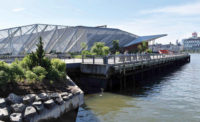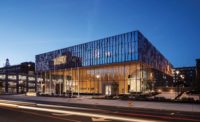For decades, New York’s South Street Seaport has been attempting a comeback. The historic neighborhood, which (from 1822 to 2005) was home to the Fulton Fish Market, and which boasts sweeping views of the Brooklyn Bridge and East River, has been the focus of numerous development schemes. The one that was built in 1985, Rouse Company’s Pier 17 Pavilion, was a “festival marketplace” designed by Benjamin Thompson & Associates, the architects of Rouse’s successful 1976 Faneuil Hall Marketplace in Boston. When it opened, to great fanfare, Pier 17 promised a retail and dining magnet that would attract locals as well as tourists—which it did for about five years, before it gradually devolved into an unremarkable indoor mall. Until its 2014 closing and subsequent demolition, the Rouse project had come to symbolize the chronic difficulty of making the neighborhood attractive both to visitors and the increasing numbers of those who have made Lower Manhattan their home.
Now a 21st-century rethink of Pier 17 is nearing completion for a summer opening, under the ownership of the Howard Hughes Corporation as part of its $785 million Seaport District redevelopment, which will ultimately include seven buildings on several city blocks housing hospitality, retail, entertainment, and cultural venues. The new Pier 17 was designed by SHoP Architects, the New York firm known for the Barclays Center arena in Brooklyn and the supertall residential tower, 111 West 57th Street, under construction in Manhattan. The 212,000-square-foot building will contain shops (including a branch of the Milanese fashion mecca 10 Corso Como), restaurants (by culinary stars like Jean-Georges Vongerichten and David Chang’s Momofuku Group), live broadcast studios for ESPN, and a 1½-acre roof for dining and public events. (The project’s landscape architect is James Corner Field Operations.)
SHoP’s design represents a more expansive and inclusive approach than that of its predecessor to the challenge of integrating into the historic area and urban fabric. Gregg Pasquarelli, one of the firm’s founders, explains that the Rouse building’s design was intended to cut tourists off from the neighborhood surrounding the Seaport, including the fish market, because it was considered dangerous. “Here you were, surrounded by amazing views on three sides, and you had a three-story shopping mall on the waterfront,” he says. SHoP’s strategy included restoring those views and facilitating pedestrian circulation, creating a much more open new building and restoring the street grid around Pier 17, to reconnect the site to its environs. “If it doesn’t have streets,” says Pasquarelli, “it doesn’t feel like New York.”
Pier 17’s design is a sophisticated take on the industrial buildings that once filled the area. The top two floors of the four-story structure are clad in a channel-glass curtain wall illuminated with a programmable LED system; the color of the glass is intended to evoke the East River’s gray-green. These upper floors serve as a “roof” for the bottom floors, which contain a village-like cluster of six distinct, two-story structures, variously clad in corrugated zinc, diamond-patterned zinc panels, and jatoba, a Brazilian cherrywood—traditional materials for old buildings here that are “used in a modern way,” Pasquarelli says. On the building’s long (north and south) sides, some bays are open, while others can be closed by 32-by-20-foot slide-up glass doors, in a nod, the architects say, to “classic New York City maritime structures.” What they describe as a “village concourse” offers paths and views through the ground floor to the outdoors; an “oculus” skylight tops the atrium above the escalators. Outdoor “porches,” as the architects call them, provide numerous places to gather and admire the views of the Brooklyn Bridge and water. These are part of SHoP’s extension of the East River Waterfront Esplanade—an ongoing project that runs from the Governors Island ferry terminal to the south, past the firm’s Pier 15 project (2011) adjacent to Pier 17, and which will continue to SHoP’s soon-to-be-completed Pier 35, about a mile to the north.
SHoP, which has been working on the Pier 17 project (for two successive owners) for well over a decade, expects to complete its next phase for the greater Seaport District by 2020. That will include the restoration and renovation of the 1907 Tin Building just west of Pier 17, which will be home to a 50,000-square-foot Jean-Georges seafood market on its ground floor. Another remnant of the old fish market, the 1939 New Market Building to the north of Pier 17, will be demolished and replaced in the project’s third phase. Given Pier 17’s outward-looking design, its upscale tenants, and its emphasis on being a good neighbor, it looks likely to be a draw for even jaded Manhattanites—if they can make their way through the throngs of tourists who are sure to show up.











